Nestled in the heart of Central America, Costa Rica beckons with its verdant landscapes, robust biodiversity, and the renowned “Pura Vida” lifestyle. As it attracts more expats, retirees, and remote workers, understanding the cost of living in Costa Rica becomes essential. Let’s delve deeper into the specifics.
1. Housing and Accommodation
The housing market in Costa Rica has undergone transformation, reflecting both local demands and international interests that must be included in our overview of the Cost of Living in Costa Rica.
a) Rentals:
Costa Rica offers a wide rental spectrum.
- San José: As the beating heart of Costa Rica, the capital witnesses elevated rental prices. Premium neighborhoods like Escazú, Sabana, or Rohrmoser are home to diplomats, business moguls, and expats, with rentals ranging from $1,000 to $2,000 for upscale condos or houses. However, more modest districts offer accommodations between $400 to $800.
- Coastal Areas: Beachside towns like Dominical, Uvita, or Samara are popular among those seeking sun and surf. A modern 2-bedroom beachfront condo can cost around $1,200 to $1,800, while further inland, prices drop to $500-$900.
- Rural & Mountain Regions: Seeking tranquility? The Central Valley or regions near Monteverde offer cooler climates and more affordable rates, typically between $300 to $600.

b) Real Estate:
The allure of owning a slice of paradise is irresistible to many. While property prices have risen, strategic investments can be lucrative.
- Urban Centers: San José and its surrounding areas, with their amenities and business opportunities, see higher property prices. A modern home in a good district can start at $200,000 and go well beyond a million for luxury properties.
- Beachfront Properties: As dream locales, areas like Manuel Antonio, Flamingo, or Nosara command premium prices. A beachfront villa might range from $300,000 to a few million, depending on size and exact location.
2. Transportation
Navigating Costa Rica efficiently requires understanding its transportation dynamics. What is the Cost of Living in Costa Rica without transportation!
a) Public Transport:
The backbone for many locals, public transportation is economical.
- Buses: Connecting even remote corners, buses are wallet-friendly. A cross-country trip, say from San José to Limón, might cost $10-$15, while local city buses are under $1.
- Trains: Serving the Central Valley, they’re a great way to avoid road congestion. A trip might cost around $1-$2, offering a scenic and affordable commute.
b) Personal Vehicles:
Owning a car in Costa Rica can be a mixed blessing. The freedom to explore comes with added costs.
- Purchasing: High import taxes can double car prices compared to North American standards. A new compact car might be around $20,000, while luxury models can exceed $100,000.
- Maintenance & Fuel:
- Given some challenging road conditions, wear and tear are common. Regular maintenance is a must, and with gasoline prices hovering around $4-$5 a gallon, long journeys can add up. Comparing to Europe, gasoline prices hover around 50% of prices there.
c) Alternative Modes:
With increasing urban congestion, alternatives are emerging.
- Bicycles: Cities like San José are slowly becoming more bike-friendly. With an average cost of $200-$500 for a reliable bike, it’s an eco-friendly option for short commutes.
- Rideshares & Taxis: Uber, Didi, and traditional taxis serve major urban centers. A typical ride within San José might be $5-$15, depending on traffic and distance.

3. Food and Culinary Delights
Embracing Costa Rican cuisine is a delightful journey, mixing indigenous traditions with international flavors. Food therefor is another necessity amongst our Cost of Living in Costa Rica.
a) Groceries:
Costa Rica’s fertile lands produce a bounty that finds its way to local markets.
- Farmers’ Markets (Ferias): A staple in every town, from the vast San José markets to tiny village setups. Fresh fruits like mangoes, pineapples, or guanabanas are incredibly cheap, often under $1 per kilo. Vegetables, dairy, and meats are similarly affordable.
- Supermarkets: With local chains like Más x Menos or international ones like Walmart, prices vary. Local products remain affordable, but imported goods, be it wines, cheeses, or specific brands, can be significantly pricier.
b) Dining Out:
Eating out in Costa Rica offers an array of experiences, from quaint ‘sodas’ to upscale restaurants.
- Local Eateries (‘Sodas’): These are Costa Rican fast food joints serving traditional dishes like ‘casado’ (a meal comprising rice, beans, plantains, salad, a protein, and possibly a fried egg) or ‘gallo pinto’ (a breakfast dish made from rice and beans). A meal at a soda, inclusive of a drink, often won’t exceed $8.
- Mid-Range Restaurants: These establishments serve both local and international cuisines. A meal for two with drinks might cost between $20 to $40. Popular dishes include fresh seafood, beef, and an array of international cuisines thanks to the expat influence.
- High-End Restaurants: In tourist hotspots and San José, gourmet restaurants offer a more refined dining experience. Expect to pay anywhere from $50 to $100 for a meal for two, especially in places with international chefs and gourmet offerings.
4. Healthcare: An Affordable Luxury
One of Costa Rica’s major attractions is its healthcare system, combining affordability with quality.
a) Public Healthcare (Caja):
Costa Rica’s universal healthcare system, run by the Caja Costarricense de Seguro Social (CCSS), is accessible to residents, including expats. Monthly contributions, based on income, provide access to a broad range of medical services. While comprehensive, wait times can sometimes be longer than in private institutions.
b) Private Healthcare:
Many expats and well-off locals prefer private healthcare due to reduced wait times and more personalized care. Facilities such as Hospital CIMA in San José or Hospital Metropolitano offer state-of-the-art services. A general consultation might range from $50 to $100, while procedures are often a fraction of U.S. prices.
c) Health Insurance:
While many expats use the Caja, others opt for private health insurance. INS, the national insurance company, provides plans, or one could consider international providers. Premiums vary by age, health conditions, and coverage levels, but often range from $50 to $300 a month.
5. Leisure and Entertainment
Costa Rica, famed for its natural beauty, offers a plethora of leisure activities.
a) Nature Activities:
Tours like canopy zip-lining, river rafting, or guided national park treks can range from $30 to $100. Surfing lessons at popular beaches like Jacó or Tamarindo might cost around $40 to $60 for a couple of hours.
b) Cultural Activities:
San José boasts theaters, museums, and galleries. Entry fees are generally modest, averaging $5 to $15. The National Theater, a cultural gem, hosts performances where ticket prices might range from $10 to $50, depending on the event.
c) Nightlife and Social Activities:
Whether you’re into salsa dancing, beachside lounges, or craft beer pubs, Costa Rica has it all. A night out in San José, including dinner, drinks, and entertainment, could cost anywhere from $30 to $100, depending on personal preferences and chosen venues.
6. Connectivity and Communication
In our digital age, staying connected is essential and is hard to avoid on our list of the Cost of Living in Costa Rica.
a) Mobile Services:
Major providers like Kolbi, Claro, and Movistar offer competitive plans. Prepaid plans are popular among expats and tourists, with monthly unlimited data plans averaging around $20 to $30. Calls and SMS costs are additional but remain affordable.
b) Internet:
Reliable internet is available in urban centers and many rural areas. Monthly plans for unlimited high-speed internet (50 Mbps to 100 Mbps) might range from $40 to $70, depending on the region and provider.
c) Cable TV and Streaming:
Packages including popular international channels can be around $30 to $60 per month. Many residents also opt for streaming services like Netflix, which have similar pricing structures to the U.S.
In conclusion, while Costa Rica offers a range of living costs, its unique blend of natural beauty, warm culture, and modern amenities makes it a compelling destination for many looking to experience the “Pura Vida” lifestyle. Adjusting expectations and being strategic about spending can lead to a comfortable and fulfilling life in this tropical paradise.

7. Education and Learning Opportunities
For families or individuals considering education or continuous learning in Costa Rica, there are a plethora of choices, representing a crucial part thinking about the Cost of Living in Costa Rica.
a) Public Schools:
Public schooling is free in Costa Rica and is mandatory for children between the ages of 6 and 15. These schools provide a basic curriculum, and while the education is decent, some expats might find it lacks certain amenities and resources common in their home countries.
b) Private Schools:
Many expats, especially from the U.S. or Europe, opt for private schools, which often follow international curriculums. Tuitions can vary significantly, from $200 a month to over $1,000 for prestigious institutions.
c) Language Schools:
Given its appeal as a travel destination, Costa Rica boasts a multitude of Spanish language schools, especially in towns like Heredia or beach destinations like Playa Samara. Weekly courses can range from $200 to $500, often including homestays or cultural immersion activities.
8. Utilities and Household Maintenance
The tropical climate plays a role in the monthly utilities bill and therefor in the Cost of Living in Costa Rica.
a) Electricity:
Due to its commitment to renewable energy, especially hydroelectric power, Costa Rica’s electricity rates are relatively stable. For a standard 2-bedroom apartment, expect monthly bills to be between $50 to $150, though this can surge if using air conditioning frequently.
b) Water and Trash Collection:
Water is generally affordable, with monthly bills averaging $10 to $30 for most households. Trash collection is often included in municipal fees or property taxes, which are nominal.
c) Household Help:
Many expats and locals employ part-time or full-time maids, gardeners, or handymen. A full-time maid might earn between $300 to $500 a month, while gardeners and handymen might charge between $5 to $10 an hour.
9. Miscellaneous Expenses
a) Personal Care:
Beauty and wellness services in Costa Rica are both quality and value for money. Haircuts can cost between $10 to $50, depending on the salon’s prestige. A massage session at a local spa might range between $30 to $70.
b) Clothing:
While local clothing is affordable, imported brands can be pricier due to import taxes. For instance, a pair of branded sneakers might be 20-30% more expensive than in the U.S.
c) Gifts and Souvenirs:
Local artisanal markets offer a variety of crafts, from handmade jewelry to wooden carvings. While some unique items might fetch higher prices, generally, souvenirs are affordable and make for meaningful gifts.

10. Navigating Finances
Understanding the financial landscape aids in making informed decisions handling the Cost of Living in Costa Rica.
a) Banking:
Costa Rica has a robust banking system, with both state and private banks. Opening an account is straightforward for residents, though some banks allow even tourists to open accounts with proper documentation. Transaction fees are nominal, but it’s essential to be aware of ATM charges, especially if using foreign cards.
b) Currency Fluctuations:
Costa Rica’s currency, the Costa Rican colón (CRC), has seen relative stability, but occasional fluctuations against the dollar can impact those relying on foreign income or pensions.
c) Taxes:
While the nation has a relatively lower tax burden than many Western countries, recent tax reforms have introduced VAT on various goods and services. However, property taxes remain low, and there are no capital gains taxes on real estate sales.
Conclusion on the Cost of Living in Costa Rica
Costa Rica, with its enticing blend of natural wonder, cultural richness, and modern amenities, is more than just a travel destination; it’s a place many choose to call home. While it may not be the cheapest country in Central America, its value proposition in terms of quality of life is unmatched. Whether you’re considering a temporary sojourn or a permanent move, being informed about the Cost of Living in Costa Rica will ensure a seamless transition to the “Pura Vida” way of life.



